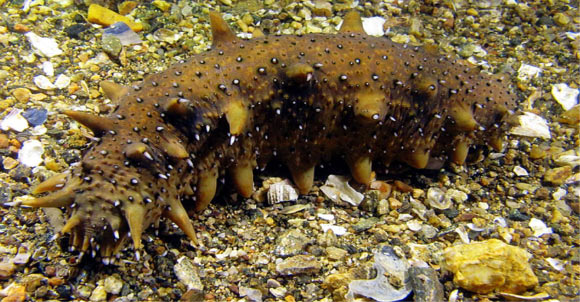An international team of researchers from Canada and China has sequenced the genome of the economically important species Apostichopus japonicus, commonly known as the Japanese spiky sea cucumber or the Japanese sea cucumber.
Sea cucumbers are members of Holothuroidea, a class of echinoderms (a phylum that also includes sea urchins and sea stars).
They are prized in the seafood and pharmaceutical industries, and are unique among echinoderms in not having a hardened calcium exoskeleton, and in their remarkable regenerative abilities.
To explore the genetic underpinnings of these features, Chinese researcher Dr. Jianhai Xiang and co-authors performed high-definition genomic sequencing of Apostichopus japonicus, covering about 92% of its estimated 880 megabases of DNA, including 30,350 protein-coding genes.
“By comparing the genome of Apostichopus japonicus with that of other organisms, we found evidence that the echinoderms diverged from hemichordates about 533 million years ago and the sea cucumbers split off from other the echinoderm classes about 479 million years ago,” the authors said.
“We found that while the sea urchin genome includes 31 genes for biomineralization, critical for forming a calcified skeleton, the sea cucumber has only seven such genes.”
“We also found that the sea cucumber expressed these biomineralization genes at much lower levels throughout development, likely accounting for their softer bodies compared to sea urchins.”

A schematic representation of the genomic characteristics of the Japanese sea cucumber (Apostichopus japonicus). Image credit: Zhang et al, doi: 10.1371/journal.pbio.2003790.
As a strategy to scare off predators, sea cucumbers can expel their viscera, which they can then regenerate within several weeks.
Dr. Xiang and colleagues found a group of duplicated genes — called PSP94-like genes — that were specifically expressed in the regenerating intestines of the sea cucumber, which had no corresponding genes in other echinoderms, suggesting that these genes may be crucial to the animals’ ability to quickly regrow their viscera.
A second group of genes called fibrinogen-related proteins were also duplicated and highly expressed during regeneration, indicating they likely contribute to this ability as well.
“The sea cucumber is a particularly promising model animal for regenerative medicine, and the availability of its genome should aid efforts to study the biology of regeneration and determine if echinoderm regrowth can offer insights that can be applied to human medicine,” said Dr. Xiang, a researcher at the Institute of Oceanology, Chinese Academy of Sciences.
“Our findings should also facilitate the understanding of the requirements for sustainable utilization and effective breeding of echinoderms, in support of the high-value sea cucumber industry, which includes its use as a source of food and traditional Chinese medicine.”
The research appears in the journal PLoS Biology.
_____
X. Zhang et al. 2017. The sea cucumber genome provides insights into morphological evolution and visceral regeneration. PLoS Biol 15 (10): e2003790; doi: 10.1371/journal.pbio.2003790








